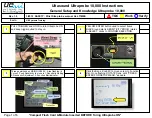
36
6
Tighten the EBP locking sleeve firmly, but not so tightly that you will have difficulty removing it later.
7
Remember that you must first activate Scuba logging by clicking the “
Scuba Logging is OFF
” hot button so that it
changes to “
Scuba Logging is ON
” (3.3, 5.5).
8
Remember to look for the red LED to blink five times to confirm that logging is activated, and the green LED blink
briefly to confirm that the Scuba is receiving adequate voltage to start logging.
Your Scuba is now logging, and will continue logging until you remove the EBP, or your batteries are depleted.
To remove the EBP, grasp the Scuba with one hand and the EBP locking sleeve with the other, and unscrew the EBP locking
sleeve. Pull the Scuba and EBP apart.
Twist only the EBP locking sleeve - twisting the entire EBP body only creates unhappiness.
5.9 Batteries and battery life
When the batteries in a Scuba battery pack are spent, logging simply ceases. It may begin again after a few hours if your batteries
recover sufficiently during that time.
Unfortunately, there are so many different combinations of sensors, water temperature, logging intervals, types of batteries, etc.
that estimation of battery life may not be very accurate. We recommend that you run the Scuba in the field to see how long the
batteries will last in your specific application.
We recommend using the highest quality alkaline batteries available, such as Duracell Copper Tops. Rechargeable batteries can
be used, but their battery life is typically only half that of non-rechargeable batteries.
We strongly recommend that you do not use lithium batteries in any Eijkelkamp battery pack. Lithium batteries don’t
like water and may cause a dangerous build-up of pressure if they get wet during a deployment. That pressure can
damage the instrument and/or you.
It’s a good idea to remove the batteries from the Scuba battery pack if the Scuba is not going to be used for a while. This
helps prevent battery leakage.
5.10 Logging redundantly with telemetry
If you wish to add redundancy to your data collection, you can connect a Scuba to a third-party data logger, telemetry
device, etc. to store data in the Scuba (using its standard logging function) and in the third-party device (according to its
manufacturer’s instructions).
Since you will be using an underwater cable, you can run power to the Scuba from a surface power supply to provide
power to Scubas – you don’t need a Scuba battery packs.
Or, the surface power supply can power Scubas with IBP’s, thus saving your batteries for emergencies such as the failure
of the surface power supply.
Either way, you will end up with data records in both the Scuba and the third-party device.
More information can be found in M-Scuba logging with uninterrupted external power supply and M-Eight ways to power
a Scuba.















































